牛津译林版(2019)选择性必修 第一册Unit 2 The Universal Language中国音乐课件(共24张PPT)
文档属性
| 名称 | 牛津译林版(2019)选择性必修 第一册Unit 2 The Universal Language中国音乐课件(共24张PPT) | 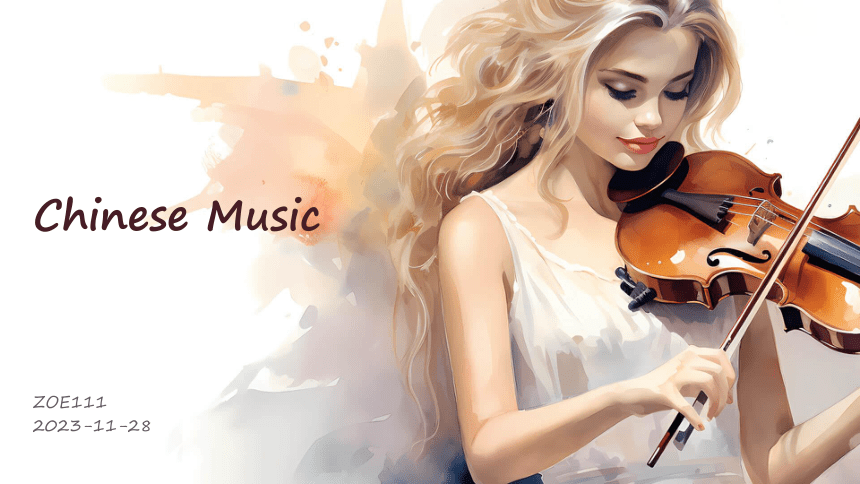 | |
| 格式 | pptx | ||
| 文件大小 | 1.3MB | ||
| 资源类型 | 教案 | ||
| 版本资源 | 牛津译林版(2019) | ||
| 科目 | 英语 | ||
| 更新时间 | 2023-11-28 20:52:39 | ||
图片预览

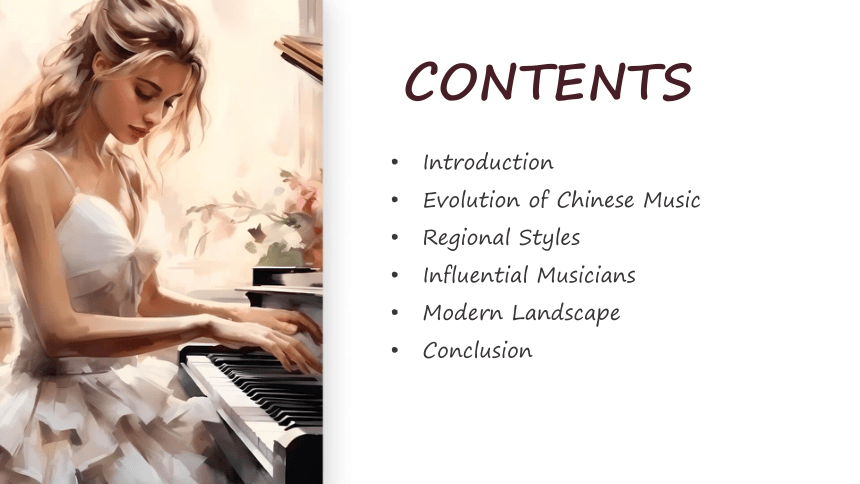
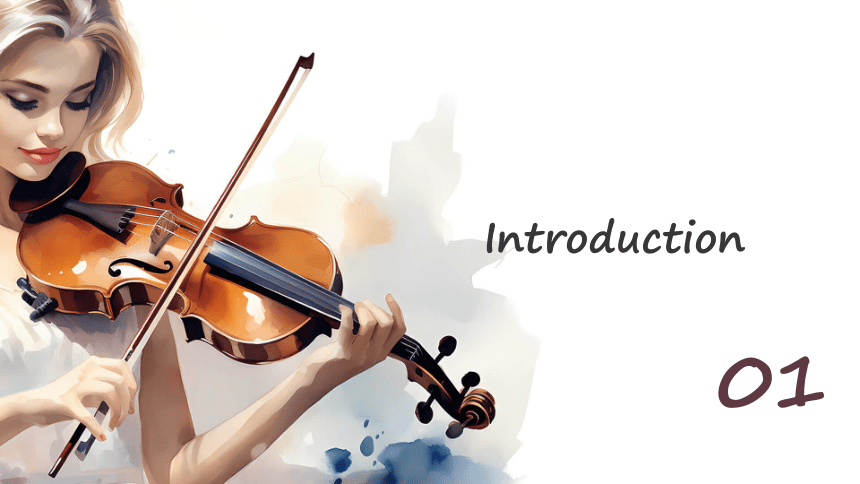
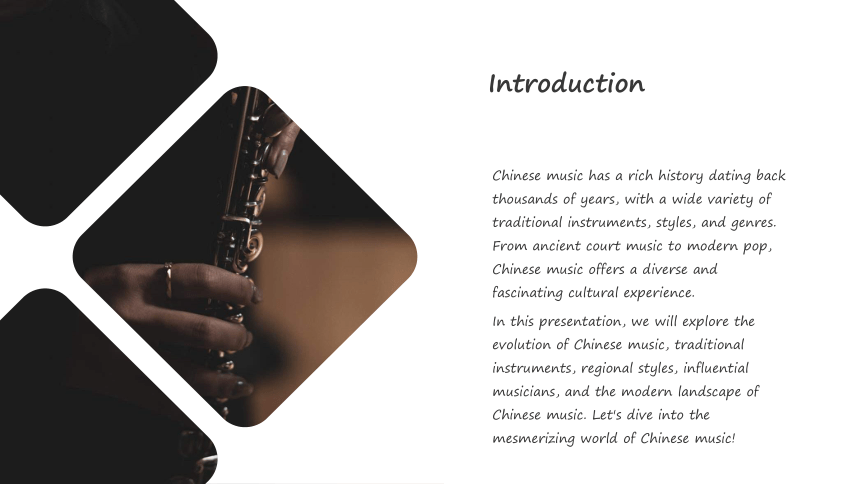
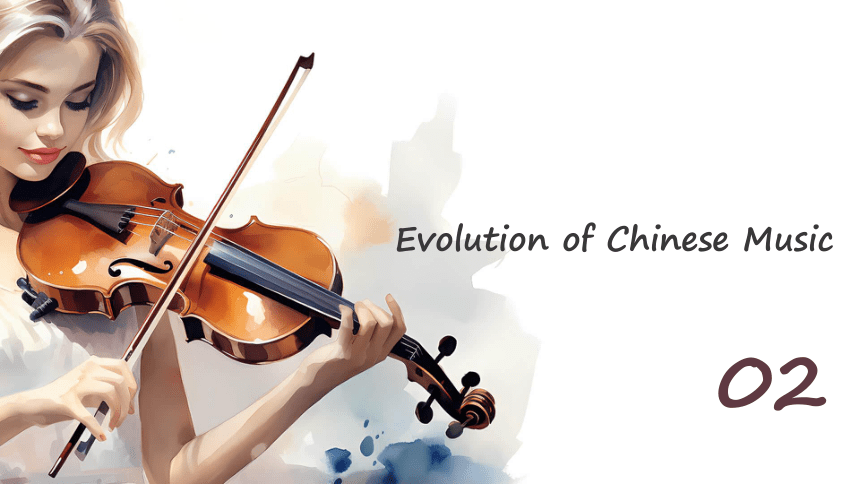
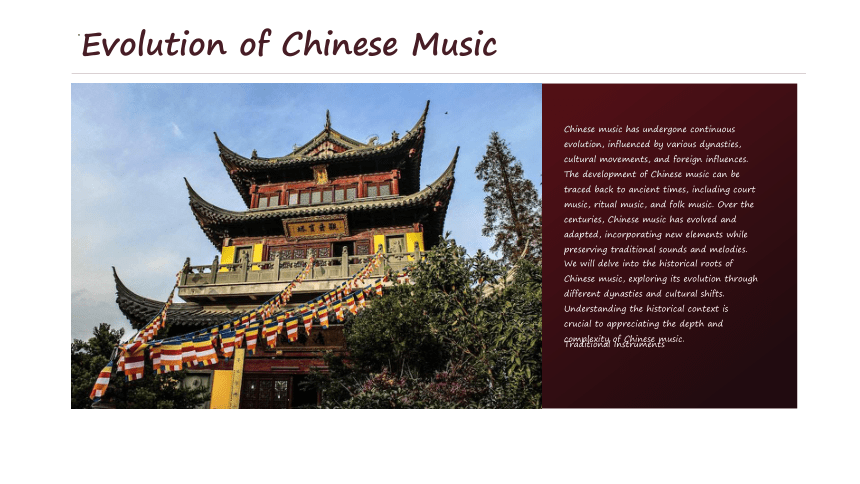
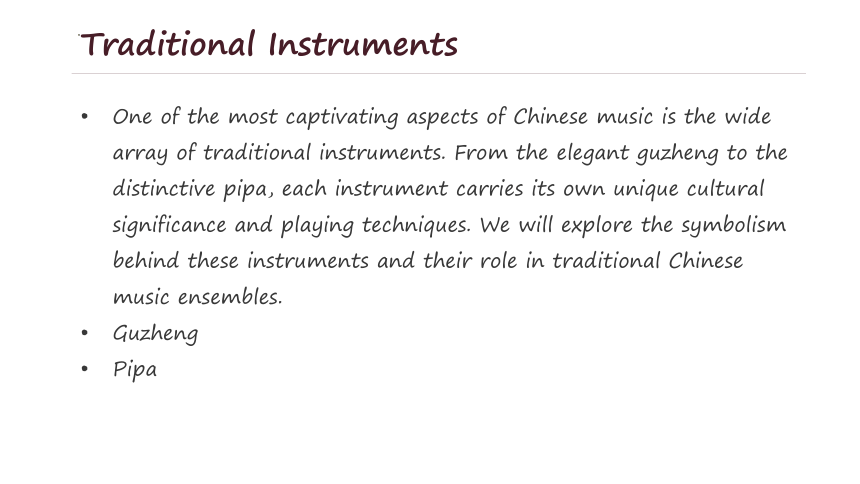
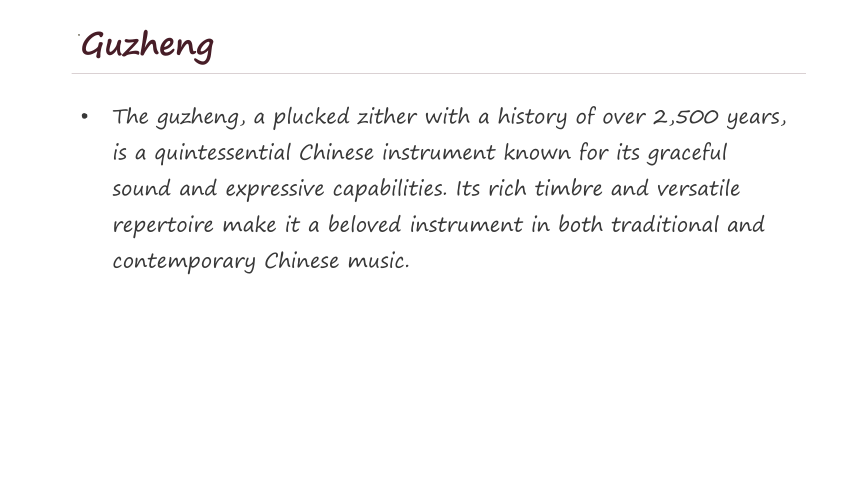
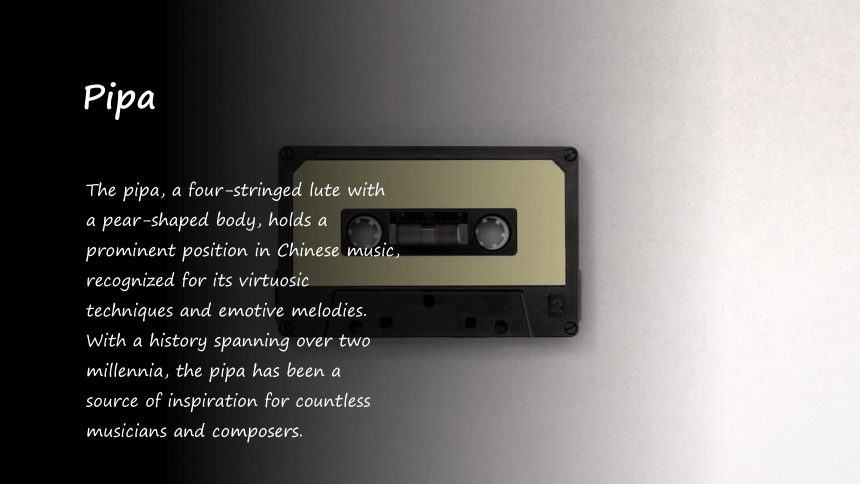
文档简介
(共24张PPT)
Chinese Music
ZOE111
2023-11-28
CONTENTS
Introduction
Evolution of Chinese Music
Regional Styles
Influential Musicians
Modern Landscape
Conclusion
01
Introduction
Introduction
Chinese music has a rich history dating back thousands of years, with a wide variety of traditional instruments, styles, and genres. From ancient court music to modern pop, Chinese music offers a diverse and fascinating cultural experience.
In this presentation, we will explore the evolution of Chinese music, traditional instruments, regional styles, influential musicians, and the modern landscape of Chinese music. Let's dive into the mesmerizing world of Chinese music!
02
Evolution of Chinese Music
Evolution of Chinese Music
Chinese music has undergone continuous evolution, influenced by various dynasties, cultural movements, and foreign influences. The development of Chinese music can be traced back to ancient times, including court music, ritual music, and folk music. Over the centuries, Chinese music has evolved and adapted, incorporating new elements while preserving traditional sounds and melodies.
We will delve into the historical roots of Chinese music, exploring its evolution through different dynasties and cultural shifts. Understanding the historical context is crucial to appreciating the depth and complexity of Chinese music.
Traditional Instruments
Traditional Instruments
One of the most captivating aspects of Chinese music is the wide array of traditional instruments. From the elegant guzheng to the distinctive pipa, each instrument carries its own unique cultural significance and playing techniques. We will explore the symbolism behind these instruments and their role in traditional Chinese music ensembles.
Guzheng
Pipa
Guzheng
The guzheng, a plucked zither with a history of over 2,500 years, is a quintessential Chinese instrument known for its graceful sound and expressive capabilities. Its rich timbre and versatile repertoire make it a beloved instrument in both traditional and contemporary Chinese music.
Pipa
The pipa, a four-stringed lute with a pear-shaped body, holds a prominent position in Chinese music, recognized for its virtuosic techniques and emotive melodies. With a history spanning over two millennia, the pipa has been a source of inspiration for countless musicians and composers.
03
Regional Styles
Regional Styles
The vastness of China's geography has given rise to diverse regional music styles, each offering a unique glimpse into the cultural identity of different regions. From the lyrical melodies of Jiangnan sizhu to the robust tunes of Northeastern folk music, regional styles showcase the breadth and depth of Chinese musical traditions.
We will journey through the distinct regional styles of Chinese music, discovering the rhythmic patterns, tonal characteristics, and cultural influences that define each style. Exploring these regional styles provides a nuanced understanding of the cultural tapestry woven into Chinese music.
Jiangnan Sizhu
Northeastern Folk Music
Jiangnan Sizhu
Originating from the Jiangnan region, Jiangnan sizhu is a refined and elegant ensemble music characterized by delicate melodies and intricate interplay between instruments. Its evocative tunes capture the serene beauty of the region's landscapes and traditions.
Northeastern Folk Music
The vibrant and dynamic melodies of Northeastern folk music reflect the vitality and resilience of the people in this vast and diverse region. With its robust rhythms and lively instrumentation, Northeastern folk music embodies the spirit of community and celebration.
04
Influential Musicians
Influential Musicians
Throughout history, Chinese music has been shaped by influential musicians who have left an indelible mark on the landscape of traditional and contemporary music. From legendary composers to virtuoso performers, these musicians have contributed to the preservation and innovation of Chinese musical heritage.
We will highlight the accomplishments and contributions of iconic Chinese musicians, shedding light on their enduring influence and creative legacy. Their artistic endeavors have paved the way for future generations of musicians and continue to inspire the flourishing realm of Chinese music.
Wang Fei
Tan Dun
Wang Fei
Wang Fei, renowned for her ethereal vocals and poetic lyricism, has redefined the boundaries of Chinese pop music, captivating audiences with her emotive performances and genre-blurring compositions. As a trailblazer in the contemporary music scene, Wang Fei has become a symbol of artistic innovation and expression.
Tan Dun
Acclaimed composer Tan Dun has seamlessly bridged the realms of traditional Chinese music and Western classical music, crafting evocative compositions that transcend cultural boundaries. His groundbreaking achievements, including the score for the film "Crouching Tiger, Hidden Dragon," have earned him international acclaim and reshaped the landscape of film music.
05
Modern Landscape
Modern Landscape
In the contemporary era, Chinese music continues to evolve and thrive, embracing new genres, technologies, and global influences. The fusion of traditional sounds with modern production techniques has given rise to a vibrant and eclectic music scene that resonates with audiences worldwide.
We will delve into the modern landscape of Chinese music, exploring the impact of globalization, digital platforms, and cross-cultural collaborations on the evolution of Chinese music. Understanding the current trends and innovations is essential in grasping the dynamic nature of Chinese music today.
Rap and Hip-Hop
Electronic Dance Music (EDM)
Rap and Hip-Hop
The emergence of Chinese rap and hip-hop has sparked a cultural phenomenon, providing a platform for artists to express social commentary, personal narratives, and urban experiences. With a growing fan base and increasing recognition, Chinese rap and hip-hop have become a driving force in contemporary music, challenging conventions and pushing creative boundaries.
Electronic Dance Music (EDM)
The integration of electronic dance music with traditional Chinese elements has resulted in a captivating fusion of soundscapes, blending ancient motifs with modern beats. This innovative approach has garnered attention on the global stage, showcasing the adaptability and creativity of Chinese musicians in the electronic music realm.
06
Conclusion
Conclusion
Chinese music encompasses a tapestry of tradition, innovation, and cultural resonance, offering a profound reflection of the country's rich heritage and creative spirit. From the classical elegance of ancient instruments to the dynamic fusion of contemporary genres, Chinese music continues to captivate and inspire audiences worldwide.
As we conclude our exploration of Chinese music, let us celebrate the enduring legacy of this art form and embrace its ongoing evolution in the global musical landscape. Through its melodies and rhythms, Chinese music invites us to embark on a timeless journey of cultural discovery and artistic expression.
THE END
THANKS
Chinese Music
ZOE111
2023-11-28
CONTENTS
Introduction
Evolution of Chinese Music
Regional Styles
Influential Musicians
Modern Landscape
Conclusion
01
Introduction
Introduction
Chinese music has a rich history dating back thousands of years, with a wide variety of traditional instruments, styles, and genres. From ancient court music to modern pop, Chinese music offers a diverse and fascinating cultural experience.
In this presentation, we will explore the evolution of Chinese music, traditional instruments, regional styles, influential musicians, and the modern landscape of Chinese music. Let's dive into the mesmerizing world of Chinese music!
02
Evolution of Chinese Music
Evolution of Chinese Music
Chinese music has undergone continuous evolution, influenced by various dynasties, cultural movements, and foreign influences. The development of Chinese music can be traced back to ancient times, including court music, ritual music, and folk music. Over the centuries, Chinese music has evolved and adapted, incorporating new elements while preserving traditional sounds and melodies.
We will delve into the historical roots of Chinese music, exploring its evolution through different dynasties and cultural shifts. Understanding the historical context is crucial to appreciating the depth and complexity of Chinese music.
Traditional Instruments
Traditional Instruments
One of the most captivating aspects of Chinese music is the wide array of traditional instruments. From the elegant guzheng to the distinctive pipa, each instrument carries its own unique cultural significance and playing techniques. We will explore the symbolism behind these instruments and their role in traditional Chinese music ensembles.
Guzheng
Pipa
Guzheng
The guzheng, a plucked zither with a history of over 2,500 years, is a quintessential Chinese instrument known for its graceful sound and expressive capabilities. Its rich timbre and versatile repertoire make it a beloved instrument in both traditional and contemporary Chinese music.
Pipa
The pipa, a four-stringed lute with a pear-shaped body, holds a prominent position in Chinese music, recognized for its virtuosic techniques and emotive melodies. With a history spanning over two millennia, the pipa has been a source of inspiration for countless musicians and composers.
03
Regional Styles
Regional Styles
The vastness of China's geography has given rise to diverse regional music styles, each offering a unique glimpse into the cultural identity of different regions. From the lyrical melodies of Jiangnan sizhu to the robust tunes of Northeastern folk music, regional styles showcase the breadth and depth of Chinese musical traditions.
We will journey through the distinct regional styles of Chinese music, discovering the rhythmic patterns, tonal characteristics, and cultural influences that define each style. Exploring these regional styles provides a nuanced understanding of the cultural tapestry woven into Chinese music.
Jiangnan Sizhu
Northeastern Folk Music
Jiangnan Sizhu
Originating from the Jiangnan region, Jiangnan sizhu is a refined and elegant ensemble music characterized by delicate melodies and intricate interplay between instruments. Its evocative tunes capture the serene beauty of the region's landscapes and traditions.
Northeastern Folk Music
The vibrant and dynamic melodies of Northeastern folk music reflect the vitality and resilience of the people in this vast and diverse region. With its robust rhythms and lively instrumentation, Northeastern folk music embodies the spirit of community and celebration.
04
Influential Musicians
Influential Musicians
Throughout history, Chinese music has been shaped by influential musicians who have left an indelible mark on the landscape of traditional and contemporary music. From legendary composers to virtuoso performers, these musicians have contributed to the preservation and innovation of Chinese musical heritage.
We will highlight the accomplishments and contributions of iconic Chinese musicians, shedding light on their enduring influence and creative legacy. Their artistic endeavors have paved the way for future generations of musicians and continue to inspire the flourishing realm of Chinese music.
Wang Fei
Tan Dun
Wang Fei
Wang Fei, renowned for her ethereal vocals and poetic lyricism, has redefined the boundaries of Chinese pop music, captivating audiences with her emotive performances and genre-blurring compositions. As a trailblazer in the contemporary music scene, Wang Fei has become a symbol of artistic innovation and expression.
Tan Dun
Acclaimed composer Tan Dun has seamlessly bridged the realms of traditional Chinese music and Western classical music, crafting evocative compositions that transcend cultural boundaries. His groundbreaking achievements, including the score for the film "Crouching Tiger, Hidden Dragon," have earned him international acclaim and reshaped the landscape of film music.
05
Modern Landscape
Modern Landscape
In the contemporary era, Chinese music continues to evolve and thrive, embracing new genres, technologies, and global influences. The fusion of traditional sounds with modern production techniques has given rise to a vibrant and eclectic music scene that resonates with audiences worldwide.
We will delve into the modern landscape of Chinese music, exploring the impact of globalization, digital platforms, and cross-cultural collaborations on the evolution of Chinese music. Understanding the current trends and innovations is essential in grasping the dynamic nature of Chinese music today.
Rap and Hip-Hop
Electronic Dance Music (EDM)
Rap and Hip-Hop
The emergence of Chinese rap and hip-hop has sparked a cultural phenomenon, providing a platform for artists to express social commentary, personal narratives, and urban experiences. With a growing fan base and increasing recognition, Chinese rap and hip-hop have become a driving force in contemporary music, challenging conventions and pushing creative boundaries.
Electronic Dance Music (EDM)
The integration of electronic dance music with traditional Chinese elements has resulted in a captivating fusion of soundscapes, blending ancient motifs with modern beats. This innovative approach has garnered attention on the global stage, showcasing the adaptability and creativity of Chinese musicians in the electronic music realm.
06
Conclusion
Conclusion
Chinese music encompasses a tapestry of tradition, innovation, and cultural resonance, offering a profound reflection of the country's rich heritage and creative spirit. From the classical elegance of ancient instruments to the dynamic fusion of contemporary genres, Chinese music continues to captivate and inspire audiences worldwide.
As we conclude our exploration of Chinese music, let us celebrate the enduring legacy of this art form and embrace its ongoing evolution in the global musical landscape. Through its melodies and rhythms, Chinese music invites us to embark on a timeless journey of cultural discovery and artistic expression.
THE END
THANKS
同课章节目录
- Unit 1 Food matters
- Welcome to the unit
- Reading
- Grammar and usage
- Integrated skills
- Extended reading
- Project
- Unit 2 The Universal Language
- Welcome to the unit
- Reading
- Grammar and usage
- Integrated skills
- Extended reading
- Project
- Unit 3 The art of painting
- Welcome to the unit
- Reading
- Grammar and usage
- Integrated skills
- Extended reading
- Project
- Unit 4 Exploring poetry
- Welcome to the unit
- Reading
- Grammar and usage
- Integrated skills
- Extended reading
- Project
